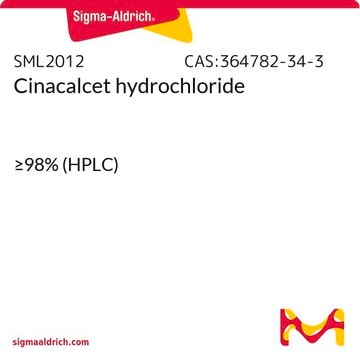Wichtige Dokumente
SML0362
NPS2143 hydrochloride
≥98% (HPLC)
Synonym(e):
2-Chloro-6-[(2R)-3-[[1,1-dimethyl-2-(2-naphthalenyl)ethyl]amino]-2-hydroxypropoxy]-benzonitrile hydrochloride (1:1), NPS-2143 hydrochloride, SB-262470-A hydrochloride
Größe auswählen
Größe auswählen
About This Item
Empfohlene Produkte
Qualitätsniveau
Assay
≥98% (HPLC)
Form
powder
Optische Aktivität
[α]20/D +20 to +24°, c = 1.0 in methanol
Lagerbedingungen
desiccated
Farbe
white to beige
Löslichkeit
DMSO: >10 mg/mL
Lagertemp.
2-8°C
SMILES String
Cl.CC(C)(Cc1ccc2ccccc2c1)NC[C@@H](O)COc3cccc(Cl)c3C#N
InChI
1S/C24H25ClN2O2.ClH/c1-24(2,13-17-10-11-18-6-3-4-7-19(18)12-17)27-15-20(28)16-29-23-9-5-8-22(25)21(23)14-26;/h3-12,20,27-28H,13,15-16H2,1-2H3;1H/t20-;/m1./s1
InChIKey
ZEBNDUQLNGYBNL-VEIFNGETSA-N
Anwendung
Biochem./physiol. Wirkung
Signalwort
Warning
H-Sätze
Gefahreneinstufungen
Acute Tox. 4 Dermal - Acute Tox. 4 Inhalation - Acute Tox. 4 Oral - Aquatic Acute 1 - Aquatic Chronic 1
Lagerklassenschlüssel
11 - Combustible Solids
WGK
WGK 3
Flammpunkt (°F)
Not applicable
Flammpunkt (°C)
Not applicable
Hier finden Sie alle aktuellen Versionen:
Analysenzertifikate (COA)
Die passende Version wird nicht angezeigt?
Wenn Sie eine bestimmte Version benötigen, können Sie anhand der Lot- oder Chargennummer nach einem spezifischen Zertifikat suchen.
Besitzen Sie dieses Produkt bereits?
In der Dokumentenbibliothek finden Sie die Dokumentation zu den Produkten, die Sie kürzlich erworben haben.
Kunden haben sich ebenfalls angesehen
Aktive Filter
Unser Team von Wissenschaftlern verfügt über Erfahrung in allen Forschungsbereichen einschließlich Life Science, Materialwissenschaften, chemischer Synthese, Chromatographie, Analytik und vielen mehr..
Setzen Sie sich mit dem technischen Dienst in Verbindung.











